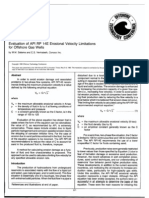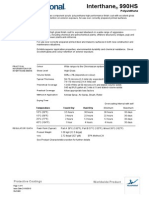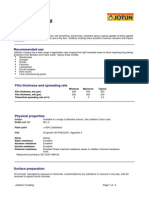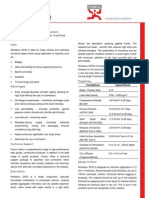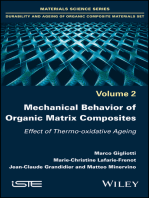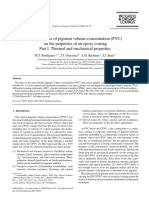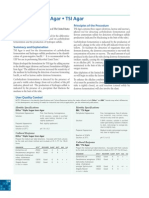Thorolastic: Water-Based, 100% Acrylic, Elastomeric, Waterproof Coating
Thorolastic: Water-Based, 100% Acrylic, Elastomeric, Waterproof Coating
Uploaded by
mrafigCopyright:
Available Formats
Thorolastic: Water-Based, 100% Acrylic, Elastomeric, Waterproof Coating
Thorolastic: Water-Based, 100% Acrylic, Elastomeric, Waterproof Coating
Uploaded by
mrafigOriginal Title
Copyright
Available Formats
Share this document
Did you find this document useful?
Is this content inappropriate?
Copyright:
Available Formats
Thorolastic: Water-Based, 100% Acrylic, Elastomeric, Waterproof Coating
Thorolastic: Water-Based, 100% Acrylic, Elastomeric, Waterproof Coating
Uploaded by
mrafigCopyright:
Available Formats
PRODUCT DATA
09 97 23
Elastomeric Coatings
THOROLASTIC
Water-based, 100% acrylic, elastomeric, waterproof coating
Features
Available in smooth, fine, and coarse textures Over 300% ultimate elongation 98% elongation recovery Flexibility at very low temperatures Internally plasticized Resistant to wind-driven rain
Description
Thorolastic is a high-build, waterbased, elastomeric, 100% acrylic, waterproof coating. It elongates over 300% to bridge dynamic cracks and retains its flexibility for years Yield 50 100 ft /gallon (1.2 2.4 m /L) per coat, depending on substrate porosity and texture. Theoretical film thicknesses are listed on page 3. Packaging 5 gallon (18.9 L) pails Color Thorolastic is available in 4 bases (pastel, medium, ultra and neutral) and 48 standard colors through the Elements color program. Color formulations are available through the electronic Thoro Tint Manual. Custom colors are available upon request. For further information, please consult your local BASF distributor or representative.
2 2
Benefits
Design versatility Bridges dynamic cracks Offers durable performance Suitable for all climates Retains flexibility for durable service Helps prevent water penetration into the substrate Allows water vapor to escape from the structure; prevents peeling and blistering 16 mils equal to 8 concrete cover Long-term durability, resists color fading Low maintenance Easy and cost efficient to maintain Environmentally friendly Versatility
Breathable Carbon-dioxide diffusion barrier Excellent color retention and UV resistance High resistance to dirt pickup Recoatable VOC compliant Also available in algae resistant (A+) formula
Texture Smooth, fine, coarse Shelf Life 18 months when properly stored. Storage Store Thorolastic in unopened containers in a clean, dry place away from direct sunlight until ready for use. Keep from freezing temperatures.
Where to Use
APPLICATION
For protecting and decorating
LOCATION
Vertical Exterior Above grade
SUBSTRATE
Stucco Concrete structures Portland cement plaster Brick and concrete masonry units (CMU) EIFS
THORO PRODUCT DATA THOROLASTIC
Technical Data
Composition Thorolastic contains water, acrylic emulsion, fillers and other proprietary ingredients.
SEALANTWATERPROOFING & RESTORATION INSTITUTE
Test Data
THOROLASTIC SMOOTH
PROPERTY RESULTS TEST METHODS
Density, lbs/gal (kg/L)
INSTITUTE
11.2 12.2 (1.34 1.46) 64.2 50 127 135 0.32 0.42 (38 50)
ASTM D 1475 ASTM D 5201
Issued to: BASF Building Systems Product: Thorolastic ASTM D 6904: Resistance to Wind Driven Rain Weight Gain: 1.0 oz. Water Leaks: none Pass 3 ASTM E 96: Moisture Vapor Transmission
WVT(grains/ft .h) 11.7 oz. Perms (grains/ft .h.in.HG) 32.5
2 2
Solids*, % By weight By volume Viscosity, KU VOC content, lbs/gal (g/L)
*Value for white
ASTM D 562 (Stormer) ASTM D 3960
ASTM D 412: Tensile Properties Tensile Strength 233 psi Elongation: 370% ASTM C 1305: Cracking Bridging Ability Results: No cracking
Pass 3 Pass 3
THOROLASTIC FINE
PROPERTY RESULTS TEST METHODS
Pass 3 ASTM D 2697: Solids Content by Volume Results:62.8% Density: 11.4 lbs/gal. Pass 3
Validation Date: 7/12/06 - 7/11/11 No. 706-TSEC711 Copyright 2006
Density, lbs/gal (kg/L) Solids, % By weight By volume Viscosity, KU VOC content, lbs/gal (g/L) THOROLASTIC COARSE
PROPERTY
10.2 11.2 (1.22 1.34) 65.5 56 127 135 0.32 0.42 (38 50)
ASTM D 1475 ASTM D 5201
SEALANT VALIDATION
www.swrionline.org
ASTM D 562 (Stormer) ASTM D 3960
RESULTS
TEST METHODS
Density, lbs/gal (kg/L) Solids, % By weight By volume Viscosity, KU VOC content, lbs/gal (g/L)
9.9 10.9 (1.19 1.31) 64.5 58 127 135 0.32 0.42 (38 50)
ASTM D 1475 ASTM D 5201
ASTM D 562 (Stormer) ASTM D 3960
THOROLASTIC SMOOTH APPLIED AT 16 MILS DFT
PROPERTY RESULTS TEST METHODS
Ultimate elongation, % Elongation recovery, % After 10 minutes After 24 hours Ultimate tensile strength, psi (MPa) Crack bridging, mils (mm) -77 F (-60 C) 32 F (0 C) 73 F (23 C) Flexibility, in (mm) mandrel, at -30 F (-34 C) Pull-off strength adhesion, psi (MPa) Wind-driven rain Water-vapor permeance, perms
344 96.9 98.4 220 (1.5) 12 (0.3) 19.5 (0.5) 27.5 (0.7) 1/8 (3) 210 (1.4) Passes 10
ASTM D 412 ASTM D 412
ASTM D 412 PR EN 1062-7
ASTM D 522 ASTM D 4541 TT-C-555B ASTM D 1653
THORO PRODUCT DATA THOROLASTIC
Test Data
THOROLASTIC SMOOTH APPLIED AT 16 MILS DFT
PROPERTY RESULTS TEST METHODS
Carbon-dioxide diffusion R (equivalent air layer thickness), ft (m) 263 (80) Sc (equivalent concrete thickness), in (cm) 8 (20) Accelerated weathering, 5,000 hrs Visual color change, 5,000 hrs Chalking, 5,000 hrs Freeze/thaw resistance, 60 cycles Salt spray resistance, 300 hrs Dirt pick-up, % after 6 months exposure Mildew resistance Passes Passes Passes Passes Passes 94 .33 No growth
PR EN 1062-6
ASTM G 23, Type D ASTM D 1729 ASTM D 4214 ASTM C 67 ASTM B 117 ASTM D 3719 ASTM D 3273 / 3274
Test results are averages obtained under laboratory conditions. Reasonable variations can be expected.
Theoretical Film Thicknesses
COVERAGE RATE FT2/GAL (M2/L) SMOOTH WET MILS DRY MILS (MICRONS) (MICRONS) WET MILS (MICRONS) FINE DRY MILS (MICRONS) COARSE WET MILS DRY MILS (MICRONS) (MICRONS)
50 (4.6) 80 (7.4) 100 (9.3)
32 (813) 20 (508) 16 (406)
16 (406) 10 (254) 8 (203)
32 (813) 20 (508) 16 (406)
18 (457) 11 (279) 9 (229)
32 (813) 20 (508) 16 (406)
19 (483) 12 (305) 9 (229)
Actual DFT to achieve the stated performance properties is 16 mils (406 microns).
How to Apply
Surface Preparation 1. Surface should be clean and sound. Concrete substrates should have a minimum 28 day cure and be free of all bond-inhibiting contaminants. 2. High-pressure water blast (or abrasive blast on hard, dense surfaces) surface to medium grit sandpaper texture (reference ICRI guide 03732 SP 3). 3. Repair any holes, spalled and damaged concrete with appropriate BASF Construction Chemicals repair materials. Remove any protruding concrete accessories and smooth out any irregularities. 4. Some stains may require chemical removal. Be sure to neutralize the compounds and rinse with clean water.
5. Remove any blisters or delaminated areas and sand edges to smooth rough areas and provide transition to old paint areas. 6. Check adhesion of old paint using ASTM D 3359, measuring adhesion by Tape Method A. 7. Treat cracks greater than 1/32 with (brand) Knife Grade or Brush Grade patching compound. Treat cracks larger than 1/4 as expansion joints and fill with appropriate BASF Construction Chemicals sealant.
CONCRETE
3. Remove all form tie wires and repair holes, small voids, and spalls using the appropriate Thoro repair product. 4. Abrasive-blast very slick, dense concrete surfaces or prime with Thoro CM Primer (see Form No. 1019088). To check for proper adhesion, a test area is recommended.
BRICK AND CONCRETE MASONRY UNITS (CMU)
1. All new CMU should be laid true and fully cured to full load-bearing capacity. 2. Remove all mortar splatter and excess mortar before coating application. 3. Repoint or fill all voids with the appropriate Thoro patching product. 4. New CMU must have a base coat of Thoro Block Filler (see Form No. 1019087) or Thoro Intermix.
1. New concrete must be cured a minimum of 28 days before application. 2. In addition to laitance and all contaminants, remove all form-release agents or previously applied sealers.
THORO PRODUCT DATA THOROLASTIC
PLASTER AND STUCCO
Mixing 1. Mechanically mix Thorolastic at slow speed with a drill and mixing paddle to ensure color uniformity and aggregate disbursement, and minimize air entrapment. 2. In multi-pail applications, mix the contents of each new pail into the partially used pail to ensure color consistency and smooth transitions from pail to pail. Application 1. Pretreat all cracks as detailed in the crack preparation section. 2. Apply Thorolastic in 2 coats by brush, spray, roller, or spray-and-backroll. Coarse texture can only be applied by spraying technique. 3. Apply Thorolastic in 2 coats to achieve a total dry-film thickness (DFT) of 16 20 mils (406 508 microns). 4. Proper wet-film thickness (WFT) must be maintained during application to ensure the performance characteristics desired (see yield rates section). 5. Always work to a natural break and maintain a wet edge during application. 6. The objective is to obtain a pinhole-free, consistent film build on all treated surfaces.
ROLLER
SPRAY
1. Clean the surface and remove all debonded or delaminated plaster or stucco. 2. Repair with Thoroseal Plaster Mix (see Form No. 1019908) modified with Acryl 60 (see Form No. 1019073). 3. Allow new plaster or stucco to cure a minimum of 14 days at 70 F (21 C) and 50% relative humidity or until the pH level has reached 10. Allow longer cure times if temperatures are lower or relative humidity is higher. 4. After cleaning and profiling, prime chalky surfaces with Thoro Primer 2K and allow primer to dry.
EXTERIOR INSULATION AND FINISH SYSTEMS (EIFS)
1. Spray application is recommended for the Coarse Texture. 2. Equipment is available for spraying all grades of Thorolastic. Typically, for smooth, large areas airless equipment is required. For fine and coarse textures, use equipment capable of handling large perlite aggregate, such as rotator/stator or diaphragm pumps with 20 40 psi (0.14 0.28 MPa) air pressure at the gun. Contact Technical Service for recommendations. 3. Backrolling is recommended with spray application. Drying Time 1. Drying time to touch is 6 hours at 70 F (21 C) and 50% relative humidity when material is applied at 18 20 mils (457 508 microns). 2. Recoat in a minimum of 12 24 hours. 3. Thorolastic requires ultraviolet (UV) light to cure. 4. Drying time will be significantly extended in cool or damp weather. 5. Protect the freshly applied Thorolastic coating from rain and condensation for a minimum of 24 hours after application. Clean Up Clean all tools and equipment with soap and water immediately after use. Clean any splatters or spills with water before material dries. Once dried, Thorolastic will be difficult to remove and may require mechanical removal.
1. Refasten or re-adhere any delaminated or loose expanded polystyrene (EPS) insulation according to manufacturers approved methods. 2. Replace or patch any missing or damaged EPS to its original condition. 3. Finish with a trowel acrylic finish to match and blend with existing texture. 4. Allow repaired areas to fully cure. 5. Refer to the EIFS manufacturers product data sheet for appropriate repair and procedures.
EXISTING ACRYLIC COATINGS
1. Sand or grind the edges of the remaining coating to ensure adhesion and a smooth transition of the new material. Sand the edges of the area to a featheredge. 2. Wash down and allow to completely dry. 3. Prime chalky surfaces with Thoro Primer 2K.
CRACK PREPARATION AND PRETREATMENT
1. Use a quality 3/4 1-1/4" (19 32 mm) nap roller cover (lambs wool preferred). 2. Completely saturate the roller and keep it loaded with the coating to build the required mils. Never dry roll. 3. Roll the coating in a consistent fanlike pattern to achieve a uniform mil thickness. 4. Cross roll to achieve a uniform thickness and maintain a wet edge. Backroll material in 1 direction as stroke variations may result in uneven color and texture.
BRUSH
1. For cracks larger than 1/32" (0.8 mm) and up to 1/16" (1.6 mm), use Thorolastic Brush Grade, an acrylic crack filler (see Form No. 1019033). 2. For cracks larger than 1/16 by 1/16" (1.6 by 1.6 mm) but less than 1/4 by 1/4" (6 by 6 mm), use Thorolastic Knife Grade, an acrylic crack filler (see Form No. 1019033). 3. If using products other than Thorolastic Knife Grade or Brush Grade, always apply a test application in a low visibility area to ensure compatibility with patching products. 4. For moving cracks larger than 1/4 by 1/4" (6 by 6 mm), use an internally plasticized polyurethane sealant. Consult with sealant manufacturer to ensure compatibility. Always apply a test application in an inconspicuous location to ensure compatibility and aesthetic approval.
1. Application by brush is recommended only for small inaccessible areas, e.g., on touch-ups. 2. Use a nylon brush only.
THORO PRODUCT DATA THOROLASTIC
For Best Performance
Do not apply to frozen or frost-covered surfaces or at temperatures (substrate or ambient) at or below 40 F (4 C) or when temperatures are expected to drop below 40 F (4 C) within 24 hours after application. Do not apply if rain is expected within 24 hours of application. Do not use on interior applications, undersides of balconies, soffits, below-grade applications or for immersion service. Elongation and crack-bridging abilities are reduced with textured grades. Do not use where there may be hydrostatic water transfer from the backside of the substrate. Do not apply to improperly sealed substrates that are subject to rising dampness or migrating moisture. Do not apply Thorolastic to sloped (less than 60) or horizontal surfaces. Application of nonelastomeric topcoats could reduce the performance properties of Thorolastic. Apply a 4 by 4 ft (1.2 by 1.2 m) test area to verify acceptable color, texture and adhesion before proceeding with any project. Adhesion should be verified by a test area. The test method for measuring adhesion is ASTM D 3359, Measuring Adhesion by Tape, Method A. On the 0 5 scale, a minimum adhesion rating of 4A is required. Make certain the most current versions of product data sheet and MSDS are being used; call Customer Service (1-800-433-9517) to verify the most current version. Proper application is the responsibility of the user. Field visits by BASF personnel are for the purpose of making technical recommendations only and not for supervising or providing quality control on the jobsite.
Health and Safety
THOROLASTIC Caution Thorolastic contains ethylene glycol, zinc oxide and crystalline quartz silica. Risks May cause skin, eye or respiratory irritation. Ingestion may cause irritation. Repeated ingestion may cause kidney damage. Precautions Avoid contact with skin, eyes and clothing. Wash thoroughly after handling. Keep container closed when not in use. DO NOT take internally. Use only with adequate ventilation. Use impervious gloves, eye protection and if the TLV is exceeded or used in a poorly ventilated area, use NIOSH/MSHA approved respiratory protection in accordance with applicable federal, state and local regulations. First Aid In case of eye contact, flush thoroughly with water for at lest 15 minutes. In case of skin contact, wash affected areas with soap and water. If irritation persists, SEEK MEDICAL ATTENTION. Remove and wash contaminated clothing. If inhalation causes physical discomfort, remove to fresh air. If discomfort persists or any breathing difficulty occurs or if swallowed, SEEK IMMEDIATE MEDICAL ATTENTION. Refer to Material Safety Data Sheet (MSDS) for further information. Proposition 65 This product contains material listed by the state of California as known to cause cancer, birth defects or other reproductive harm. VOC Content 0.32 0.63 lbs/gal or 38 75 g/L, or less water and exempt solvents. For medical emergencies only, call ChemTrec (1-800-424-9300).
THORO PRODUCT DATA THOROLASTIC
BASF Construction Chemicals, LLC Building Systems 889 Valley Park Drive Shakopee, MN, 55379 www.BuildingSystems.BASF.com Customer Service 800-433-9517 Technical Service 800-243-6739
LIMITED WARRANTY NOTICE Every reasonable effort is made to apply BASF exacting standards both in the manufacture of our products and in the information which we issue concerning these products and their use. We warrant our products to be of good quality and will replace or, at our election, refund the purchase price of any products proved defective. Satisfactory results depend not only upon quality products, but also upon many factors beyond our control. Therefore, except for such replacement or refund, BASF MAKES NO WARRANTY OR GUARANTEE, EXPRESS OR IMPLIED, INCLUDING WARRANTIES OF FITNESS FOR A PARTICULAR PURPOSE OR MERCHANTABILITY, RESPECTING ITS PRODUCTS, and BASF shall have no other liability with respect thereto. Any claim regarding product defect must be received in writing within one (1) year from the date of shipment. No claim will be considered without such written notice or after the specified time interval. User shall determine the suitability of the products for the intended use and assume all risks and liability in connection therewith. Any authorized change in the printed recommendations concerning the use of our products must bear the signature of the BASF Technical Manager. This information and all further technical advice are based on BASFs present knowledge and experience. However, BASF assumes no liability for providing such information and advice including the extent to which such information and advice may relate to existing third party intellectual property rights, especially patent rights. In particular, BASF disclaims all CONDITIONS AND WARRANTIES, WHETHER EXPRESS OR IMPLIED, INCLUDING THE IMPLIED WARRANTIES OF FITNESS FOR A PARTICULAR PURPOSE OR MERCHANTABILITY. BASF SHALL NOT BE RESPONSIBLE FOR CONSEQUENTIAL, INDIRECT OR INCIDENTAL DAMAGES (INCLUDING LOSS OF PROFITS) OF ANY KIND. BASF reserves the right to make any changes according to technological progress or further developments. It is the customers responsibility and obligation to carefully inspect and test any incoming goods. Performance of the product(s) described herein should be verified by testing and carried out only by qualified experts. It is the sole responsibility of the customer to carry out and arrange for any such testing. Reference to trade names used by other companies is neither a recommendation, nor an endorsement of any product and does not imply that similar products could not be used.
For professional use only. Not for sale to or use by the general public.
Form No. 1019110 12/07 Printed on recycled paper including 10% post-consumer fiber.
2007 BASF Printed in U.S.A.
You might also like
- Powder Coating ProcedureDocument2 pagesPowder Coating Procedureshrikanth5singh100% (4)
- Boral Micron: Workability, Shrinkage Crack Resistance, and High Strength ConcreteDocument5 pagesBoral Micron: Workability, Shrinkage Crack Resistance, and High Strength ConcretemrafigNo ratings yet
- Methodology For PODIUM Landscape WP Polyurea WH 200 PDFDocument10 pagesMethodology For PODIUM Landscape WP Polyurea WH 200 PDF폴로 쥰 차No ratings yet
- Methodology For TERRACE Waterproofing NITOPROOF 600 PDFDocument7 pagesMethodology For TERRACE Waterproofing NITOPROOF 600 PDF폴로 쥰 차100% (2)
- 9235 Waterproofing Membrane: Advantages and CertificationsDocument5 pages9235 Waterproofing Membrane: Advantages and CertificationsatharkNo ratings yet
- Salama and Venktash OTC 4485Document6 pagesSalama and Venktash OTC 4485Ian VeltmanNo ratings yet
- Maxifloor MFT 363 SL Epoxy Top CoatDocument2 pagesMaxifloor MFT 363 SL Epoxy Top Coattaufik majitNo ratings yet
- Jotafloor Topcoat - English (Uk) - Issued.06.12.2007Document4 pagesJotafloor Topcoat - English (Uk) - Issued.06.12.2007Mohamed FaragNo ratings yet
- Amerlock 400 Sigmacover 400Document6 pagesAmerlock 400 Sigmacover 400Vijay KumarNo ratings yet
- Inter Therm 228Document4 pagesInter Therm 228Mehman NasibovNo ratings yet
- Interzone 954Document0 pagesInterzone 954hennawijayaNo ratings yet
- TDS Nitomortar TC2000 Saudi ArabiaDocument3 pagesTDS Nitomortar TC2000 Saudi ArabiaHarry BawingNo ratings yet
- Nitomortar TC2000Document3 pagesNitomortar TC2000MuhammedHafis100% (1)
- Fosroc Conbextra GP2Document4 pagesFosroc Conbextra GP2awsdhnjkklmNo ratings yet
- Interzone 1000: Glass Flake EpoxyDocument4 pagesInterzone 1000: Glass Flake EpoxyAnindya Aulia PratiwiNo ratings yet
- Interthane 990 HS DatasheetDocument4 pagesInterthane 990 HS DatasheetBalasubramanian Ananth100% (1)
- Intertherm 228HS Eng A4Document4 pagesIntertherm 228HS Eng A4treazer_jetaimeNo ratings yet
- Cemtop 400SD: Cement Based, Self Levelling, Industrial Floor Surfacing System - 6mm To 12mmDocument4 pagesCemtop 400SD: Cement Based, Self Levelling, Industrial Floor Surfacing System - 6mm To 12mmBalasubramanian AnanthNo ratings yet
- PPG PDS Amercoat 370Document7 pagesPPG PDS Amercoat 370sanguripNo ratings yet
- Interzone 954Document4 pagesInterzone 954johnson_regoNo ratings yet
- MAXIFLOOR MFT 100 3K Epoxy SelfsmoothingDocument2 pagesMAXIFLOOR MFT 100 3K Epoxy Selfsmoothingarslanalan63No ratings yet
- Interline 399Document4 pagesInterline 399pinky_y2kNo ratings yet
- Nitoflor FC150Document4 pagesNitoflor FC150Mohammad Abu Al-ToyourNo ratings yet
- Renderoc TgxtraDocument2 pagesRenderoc TgxtraBalasubramanian Ananth100% (3)
- DecoFloor_TDSDocument3 pagesDecoFloor_TDSsherinaroy516No ratings yet
- Nitomortar ELDocument4 pagesNitomortar ELmilanbrasinaNo ratings yet
- Jotafloor: Traffic Deck SystemDocument12 pagesJotafloor: Traffic Deck SystemUnited Construction Est. TechnicalNo ratings yet
- Conbextra GP TDSDocument4 pagesConbextra GP TDSMoataz MedhatNo ratings yet
- Jotafloor Coating - English (Uk) - Issued.06.12.2007Document4 pagesJotafloor Coating - English (Uk) - Issued.06.12.2007Mohamed FaragNo ratings yet
- Conbextra HFDocument4 pagesConbextra HFUbaid Mazhar Abidi SyedNo ratings yet
- Sikafloor261sys1 PdsDocument4 pagesSikafloor261sys1 PdsTPNo ratings yet
- Nitoseal 290Document4 pagesNitoseal 290shanon33No ratings yet
- Conbextra EP300Document3 pagesConbextra EP300Tori SmallNo ratings yet
- Nitomortar ElDocument4 pagesNitomortar ElBalasubramanian AnanthNo ratings yet
- Jotafloor Topcoat: Technical DataDocument4 pagesJotafloor Topcoat: Technical DataMohamed FarhanNo ratings yet
- Duracrete FichaDocument2 pagesDuracrete FichavankarpNo ratings yet
- 7 Renderoc SP30Document4 pages7 Renderoc SP30samueltee212No ratings yet
- Maxifloor MFT 323 SL Epoxy CoatingDocument2 pagesMaxifloor MFT 323 SL Epoxy CoatinganggaNo ratings yet
- Dimetcote 9 Sigmazinc 9Document6 pagesDimetcote 9 Sigmazinc 9kaleshNo ratings yet
- Lucite400 Acrylic LQ TDSDocument6 pagesLucite400 Acrylic LQ TDSLjy AlarvaNo ratings yet
- Amerlock® 400 Voc: Product Data SheetDocument8 pagesAmerlock® 400 Voc: Product Data SheetCris gomezNo ratings yet
- TDS CONBEXTRA EP300 Saudi ArabiaDocument3 pagesTDS CONBEXTRA EP300 Saudi ArabiaShaikhRizwanNo ratings yet
- Amercoat 78HBDocument6 pagesAmercoat 78HBVijay KumarNo ratings yet
- Rex ThaneDocument4 pagesRex Thanesas999333No ratings yet
- Amer240 Edge CoverageDocument4 pagesAmer240 Edge CoverageEugene DoyleNo ratings yet
- SonoShield HLM 5000 - Bitumen MembraneDocument6 pagesSonoShield HLM 5000 - Bitumen MembraneOgbedande Awo OrunmilaNo ratings yet
- Amercoat® 385: Product Data SheetDocument8 pagesAmercoat® 385: Product Data SheetNizar BouchaalaNo ratings yet
- Jazeera Epo-Mortar SL5000Document3 pagesJazeera Epo-Mortar SL5000Ahmad BougeisNo ratings yet
- UHT (Spray Grade) : Product Summary Typical Chemical Resistance (Full Immersion)Document2 pagesUHT (Spray Grade) : Product Summary Typical Chemical Resistance (Full Immersion)rezaeifNo ratings yet
- Jotafloor TC EDocument6 pagesJotafloor TC ERidwanSalminNo ratings yet
- Fosroc Nukote ST: Constructive SolutionsDocument4 pagesFosroc Nukote ST: Constructive SolutionsRaj PatelNo ratings yet
- Nitomortar TC2000Document3 pagesNitomortar TC2000grtunaNo ratings yet
- Interline 1012+ds+engDocument4 pagesInterline 1012+ds+engSUBHOMOYNo ratings yet
- Epoxy Flooring TDSDocument7 pagesEpoxy Flooring TDSMohamed MagdiNo ratings yet
- Nitoproof 600Document4 pagesNitoproof 600sandeepuaeNo ratings yet
- Semigloss 90 - 1210 PDSDocument6 pagesSemigloss 90 - 1210 PDSPablo PuebloNo ratings yet
- Renderoc FCXtra SubmittalDocument35 pagesRenderoc FCXtra SubmittalAjit Singh Rathore100% (1)
- E-Program Files-AN-ConnectManager-SSIS-TDS-PDF-Intercryl - 988 - Eng - A4 - 20150205Document4 pagesE-Program Files-AN-ConnectManager-SSIS-TDS-PDF-Intercryl - 988 - Eng - A4 - 20150205Antonio Diaz FeireNo ratings yet
- Roll-to-Roll Manufacturing: Process Elements and Recent AdvancesFrom EverandRoll-to-Roll Manufacturing: Process Elements and Recent AdvancesJehuda GreenerNo ratings yet
- Hydrostatic and Hydro-Testing in the Oil and Gas FieldFrom EverandHydrostatic and Hydro-Testing in the Oil and Gas FieldRating: 3 out of 5 stars3/5 (2)
- Mechanical Behavior of Organic Matrix Composites: Effect of Thermo-oxidative AgeingFrom EverandMechanical Behavior of Organic Matrix Composites: Effect of Thermo-oxidative AgeingNo ratings yet
- Pps BrochureDocument16 pagesPps BrochuremrafigNo ratings yet
- Water Chemistry in Thermal Power Plants-1Document42 pagesWater Chemistry in Thermal Power Plants-1mrafigNo ratings yet
- Ramnarain Ruia Autonomous CollegeDocument16 pagesRamnarain Ruia Autonomous CollegemrafigNo ratings yet
- Evaluation of Various Cellulose Ethers in Tile AdhesivesDocument9 pagesEvaluation of Various Cellulose Ethers in Tile AdhesivesmrafigNo ratings yet
- Alcofine Geopolymer ConcreteDocument11 pagesAlcofine Geopolymer ConcretemrafigNo ratings yet
- Indian Institute of Food Processing Technology: Food Safety and Quality Testing Laboratory (DFSQT)Document3 pagesIndian Institute of Food Processing Technology: Food Safety and Quality Testing Laboratory (DFSQT)mrafigNo ratings yet
- Ultrafine Study RPTDocument19 pagesUltrafine Study RPTmrafigNo ratings yet
- CN101407428A - Concrete Superficial Hardener Patent SummaryDocument13 pagesCN101407428A - Concrete Superficial Hardener Patent SummarymrafigNo ratings yet
- Alccofine Packing DensityDocument15 pagesAlccofine Packing DensitymrafigNo ratings yet
- High Reactivity: Metakaolin PozzolanDocument2 pagesHigh Reactivity: Metakaolin PozzolanmrafigNo ratings yet
- FLOOR-PRO 601 LIQUID FLOOR HARDENER Is A One-ComponentDocument3 pagesFLOOR-PRO 601 LIQUID FLOOR HARDENER Is A One-ComponentmrafigNo ratings yet
- 2018 Yearly CalendarDocument72 pages2018 Yearly CalendarmrafigNo ratings yet
- Hanly C Reduction CertDocument1 pageHanly C Reduction CertmrafigNo ratings yet
- HORIBA Emission Monitoring Solutions For Power PlantsDocument1 pageHORIBA Emission Monitoring Solutions For Power PlantsmrafigNo ratings yet
- National Testing Laboratories, LTDDocument20 pagesNational Testing Laboratories, LTDmrafig100% (1)
- Agilent Uv Spec MethodsDocument218 pagesAgilent Uv Spec MethodsmrafigNo ratings yet
- Conversion Tables: Unit of ConcentrationDocument1 pageConversion Tables: Unit of ConcentrationmrafigNo ratings yet
- IC Quiz QuestionsDocument2 pagesIC Quiz Questionsrohan NathNo ratings yet
- Beer Recovery ArticleDocument4 pagesBeer Recovery ArticleAndor MolitoriszNo ratings yet
- Research Paper HPLCDocument9 pagesResearch Paper HPLCafnhiheaebysya100% (1)
- The Influence of Pigment Volume Concentration (PVC)Document6 pagesThe Influence of Pigment Volume Concentration (PVC)chemsiton100% (1)
- Carbon Steel and Low-Alloy Steel Pressure-Vessel-Component Forgings With Mandatory Toughness RequirementsDocument4 pagesCarbon Steel and Low-Alloy Steel Pressure-Vessel-Component Forgings With Mandatory Toughness RequirementsStanley HallNo ratings yet
- Limiting & Excess ReactantDocument19 pagesLimiting & Excess ReactantAlmira Sophie SyamsudinNo ratings yet
- Polymer PropertiesDocument23 pagesPolymer PropertiesNugroho Faris SudrajatNo ratings yet
- Quantitative Analysis of Phytochemicals Constituent of Melegueta Pepper SeedDocument5 pagesQuantitative Analysis of Phytochemicals Constituent of Melegueta Pepper SeedInternational Journal of Innovative Science and Research TechnologyNo ratings yet
- Improving The Quality of Building Materials International Norms For Tile Adhesives and GroutsDocument12 pagesImproving The Quality of Building Materials International Norms For Tile Adhesives and GroutsMaha MuflehNo ratings yet
- Problem Set 5Document2 pagesProblem Set 5SourasishNo ratings yet
- TA - Potential of Air Lift PumpsDocument6 pagesTA - Potential of Air Lift PumpsMohamed Tarek KamarNo ratings yet
- A2 Unit 6 June 2016Document24 pagesA2 Unit 6 June 2016Peranut YlNo ratings yet
- Heat Tracing Design Guide For Self Regulating CablesDocument30 pagesHeat Tracing Design Guide For Self Regulating CablesReza ZigheimatNo ratings yet
- 065 Isopropyl AlcoholDocument7 pages065 Isopropyl Alcoholeng20072007No ratings yet
- Gold Questions: Solid State ChemistryDocument7 pagesGold Questions: Solid State Chemistryabhishek pathakNo ratings yet
- Triple Sugar Iron AgarDocument3 pagesTriple Sugar Iron AgarmaniNo ratings yet
- Course DiaryDocument66 pagesCourse DiaryAishwarya RaviNo ratings yet
- Material Cross ReferenceDocument1 pageMaterial Cross Referencebidmastermind2024No ratings yet
- Industrijski Izmenjivaci Toplote GEA, Tip VCIDocument16 pagesIndustrijski Izmenjivaci Toplote GEA, Tip VCIAleksandarAndric100% (1)
- Exchange With The Environment Ch4.1 7th PDF (Information Obtained From Holt Science and Technology: Life Science. Austin: Holt Rinehart & Winston, 2007. Print.)Document18 pagesExchange With The Environment Ch4.1 7th PDF (Information Obtained From Holt Science and Technology: Life Science. Austin: Holt Rinehart & Winston, 2007. Print.)thegedusNo ratings yet
- Ketones and AldehydesDocument10 pagesKetones and AldehydesManjeeta Mandlik0% (1)
- Asian J Org Chem - 2022 - Yang - Fixation of Carbon Dioxide With Functionalized Ionic LiquidsDocument15 pagesAsian J Org Chem - 2022 - Yang - Fixation of Carbon Dioxide With Functionalized Ionic LiquidsShailendraNo ratings yet
- 1 NaphtholDocument7 pages1 NaphtholWalid Ebid ElgammalNo ratings yet
- Multidisciplinary Design Project Engineering DictionaryDocument115 pagesMultidisciplinary Design Project Engineering DictionarySohail ShaikhNo ratings yet
- Desalination of Sea WaterDocument23 pagesDesalination of Sea WaterPriya RajNo ratings yet
- Science 6 - Quarter 1 - Quiz No. 1Document1 pageScience 6 - Quarter 1 - Quiz No. 1KervinNo ratings yet
- Bio ProjectDocument13 pagesBio ProjectAdarsh Kumar MohapatraNo ratings yet






